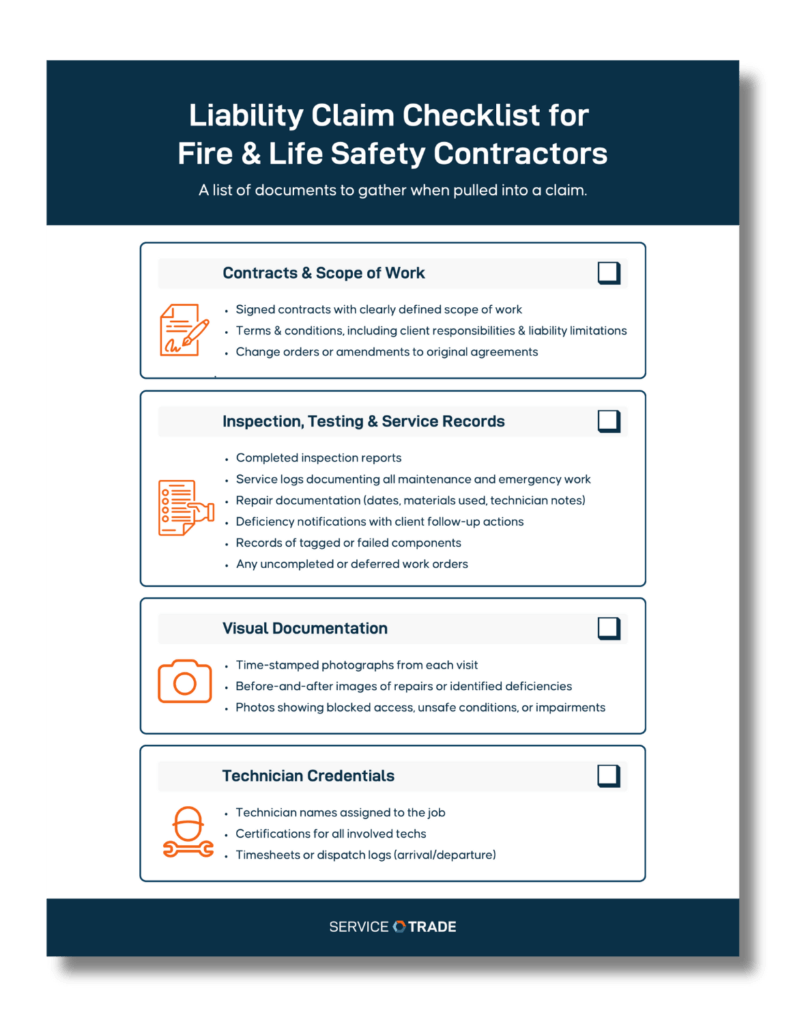Webinar Recap: 3 Costly Mistakes Fire Protection Contractors Make

You know safety comes first. But even experienced contractors can fall into patterns that lead to more risk and less profit. In a recent ServiceTrade webinar, industry experts shared the top three mistakes they see and what to do instead.
Here’s the recap.
Mistake #1: Relying on Paper and Manual Processes
“Moving away from paper isn’t just a tech upgrade—it’s a risk reduction strategy.”
Manual methods are still surprisingly common in the industry—from paper inspection forms to spreadsheets and siloed communication. While they may feel familiar, they introduce risk at every step.
Why is this a problem? Because paper forms get lost. Data entry gets delayed, or skipped. Inspection reports are incomplete or non-compliant. The result? Increased exposure to legal claims, delays in invoicing, and a trail of inconsistencies that inspectors and customers alike notice.
What to do instead:
Digital inspection forms, especially ones that are NFPA-compliant and mobile-friendly, help standardize and streamline the entire workflow. With required fields, code references, and real-time sync, technicians are guided through inspections accurately. You get faster, better inspections with less chance of missing something important.
Mistake #2: Missing Inspections and Inconsistent Follow-Ups
“If you’re not proactively managing your service intervals, you’re playing defense. Automation is what turns you into a strategic partner.”
It’s easy to fall behind on recurring inspections, especially when juggling multiple contracts and jurisdictions. But missed service dates can cause serious headaches: fines, unhappy customers, and even lost contracts.
What to do instead:
Automate scheduling with software that reminds your team when inspections are due and follows up on repairs. It can even send reminders to customers. This helps you stay on top of everything without extra stress.
Mistake #3: Weak Documentation of Deficiencies and Repairs
“Documentation is about protecting your team and proving your value. It turns your work into evidence.”
Think of documentation as your business’s insurance policy. When it’s weak or incomplete, your exposure grows.
Inadequate records can lead to denied insurance claims, lawsuits, failed inspections, or lost trust. It also slows down internal communication—causing confusion between technicians, office staff, and customers.
What to do instead:
Build a detailed documentation system. Every deficiency, every repair, every customer interaction should be captured in a centralized platform with photos, notes, timestamps, and signatures included. This makes service transparent, both internally and to regulators.
Better Systems = Better Business and Less Risk
“Your systems should make your life easier, not harder.”
The most successful fire protection contractors aren’t just great at inspections, they’re great at operations. What separates them is how well their internal systems support accuracy, speed, and accountability.
With the right platform in place, you can:
- Follow NFPA rules every time
- Stay on schedule and never miss inspections
- Send invoices faster and get paid sooner
- Make customers feel confident in your work
- Help your team stay focused without burning out
ServiceTrade gives you the tools to make all this happen—without adding more stress to your day.
Next Steps:
If this summary piqued your interest, check out the full webinar recording here.
Download the Liability Claim Checklist for Fire & Life Safety Contractors


Billy Marshall explores how Fire Protection contractors can boost growth and productivity with technology in this recording of Off the Record with Paul Giannamore filmed at the NFPA Conference. Billy Marshall, founder of ServiceTrade, understands the business of commercial service for fire protection equipment, which is why he founded Service Trade—a platform designed to help contractors streamline inspections, […]
In the fire protection industry, inspections are more than a compliance checkbox—they’re the gateway to stronger customer relationships, more predictable revenue, and a more efficient service operation. But for too long, inspections have been riddled with delays and disruptions, fragmented systems, and manual processes that limit your team’s productivity and profitability. That’s why we built […]
